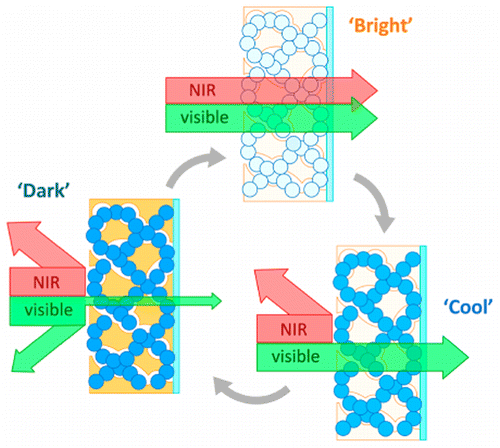Imagine a window that with a flick of a switch can let light in, but not heat. Or heat but not light. Or both. Or neither.
It could save on energy bills for homes and offices, and give people more control and comfort.
These advancements show that sophisticated dynamic control of sunlight is possible. This material could be ideal for application as a smart electrochromic window for buildings– Delia Milliron, University of Texas
Researchers in Texas claim to have solved the puzzle of creating such a window, and they say commercial production is not far off.
The seed of the idea came in 2013 when chemical engineering professor Delia Milliron and her team at the Cockrell School of Engineering at the University of Texas at Austin became the first to develop dual-band electrochromic materials that blend two materials with distinct optical properties for selective control of both visible and heat-producing near-infrared light (NIR).
Milliron’s group demonstrated how, using a small jolt of electricity, a nanocrystal material could be switched back and forth, enabling independent control of light and energy.
Now the team has engineered two new advances in electrochromic materials – a highly selective cool mode and a warm mode not thought possible several years ago.
Minutes to switch
They are calling it a "major step toward a commercialised product" because it enables control of 90% of NIR and 80% of the visible light from the sun, and takes only minutes to switch between modes, whereas their previously reported material could require hours.
To achieve this high performance, Milliron’s team developed a new nanostructured architecture for electrochromic materials that allows for a "cool" mode to block NIR while allowing visible light to shine through.
They reported the new architecture in Nano Letters on July 20.
The paper demonstrates how the new material can modulate visible light and NIR by applying a small voltage.

How "dark", "bright" and "cool" modes can be achieved by the new electrochromic material (Cockrell School of Engineering, University of Texas at Austin)
"We believe our new architected nanocomposite could be seen as a model material, establishing the ideal design for a dual-band electrochromic material," Milliron said. "This material could be ideal for application as a smart electrochromic window for buildings."
To optimise performance, the team organised the two components of the composite material to create a porous interpenetrating network.
The architecture provides channels for transport of electronic and ionic change and enables substantially faster switching between modes.
Good for a winter’s day
The researchers are now working on a similarly structured nanocomposite material by simple methods, suitable for low-cost manufacturing.
In another research paper this month, published in the Journal of the American Chemical Society, Milliron and her team reported a proof-of-concept demonstrating how they can achieve optical control properties in windows from a single-component film.
The concept includes a simple coating that creates a new "warm" mode, in which visible light can be blocked, while near-infrared light can enter – useful on a sunny winter day, when an occupant wants more warmth and less glare.
"These two advancements show that sophisticated dynamic control of sunlight is possible," Milliron said. "We believe our deliberately crafted nanocrystal-based materials could meet the performance and cost targets needed to progress toward commercialisation of smart windows."
- From a Cockrell School of Engineering press release
Main photograph: Sun glare in St. Louis, Missouri (Leslie/Wikimedia Commons)










